Final Fantasy XV: Acquiring resources and creating spells
We're done with the introduction to the spell system and it's time to do some spell crafting. In this chapter you will learn about the sources of raw elements which form the core of the spell and about catalysts - where can you get them and how can you use them.
- Raw elements
- Catalysts
- Creating spells
- Spell tiers
- Increasing spell Potency
- Adding raw elements into the mixture
- Additional spell effects
Raw elements
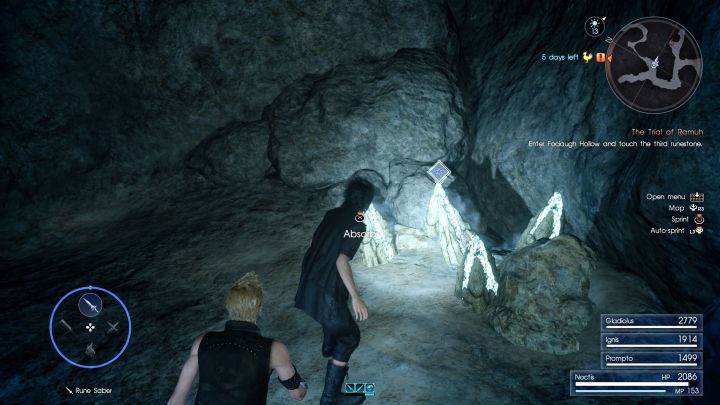
The most important components used in the process of spell creation are raw elements. Elements present in the game are: Fire, Ice and Lightning. The type of damage the spell will deal, as well as some additional effects (like burning, slowing, and so on) depends entirely on those three.
You can see three containers, one for each element, on the spell creation (Elemancy) window. Each container can hold up to 99 units of raw elements - once the container is full, you won't be able to acquire more raw elements, unless you use some of the already accumulated. There are two main sources of raw elements in the game:
- Deposits - those are, basically, points from where you can extract a specific element. Deposits are marked with special icons (depending on the type of element) on the map, allowing you to easily locate them.
- Defeating enemies with specific weapons. Every enemy killed (last hit) with one of those weapons has a small chance to drop a few points of raw elements.
Normally you can extract 33 units of a specific element from a deposit, although this number can be significantly increased by unlocking abilities from the "Magic" tree - Elementalism, Elementality and Enhanced Elementality. A deposit is depleted once you extract all units out of it, but it will regenerate once a full in-game day passes.
Deposits can be found throughout the game. The easiest way is to simply head to a place where you can camp (where you can set up a camp and spend the night) - there will always be a Fire, Ice and Lightning deposit located there. Deposits can also be found in dungeons and places you visit during story-related quests.
As mentioned above, raw elements can also be acquired by eliminating enemies (delivering a killing blow) with certain weapons. Those weapons are:
- Engine Blade, Ultima Blade - sword
- Force Stealer - greatsword
- Plunderer - daggers
- Drain Lance - polearm
- Valiant - firearm
- Absorb Shield - shield
By default, every enemy has a 50% chance to drop a small amount of raw elements when killed with one of the above listed weapons. Those aren't large numbers (2-3 in average), which is why this method shouldn't be used as a main source of raw elements. However, most of those weapons (and especially their upgraded versions - which you can read about in one of the chapters of this guide) have decent stats - using them in combat won't put you at a disadvantage when compared to "regular" weapons.
The best method is to extract raw elements from deposits and supplement it with points gathered by eliminating enemies. You should also invest in one of the abilities of the "Magic" tree, Elementalism. It costs only 24 AP but it will significantly increase the amount of raw elements you are capable of extracting from a deposit.
Catalysts
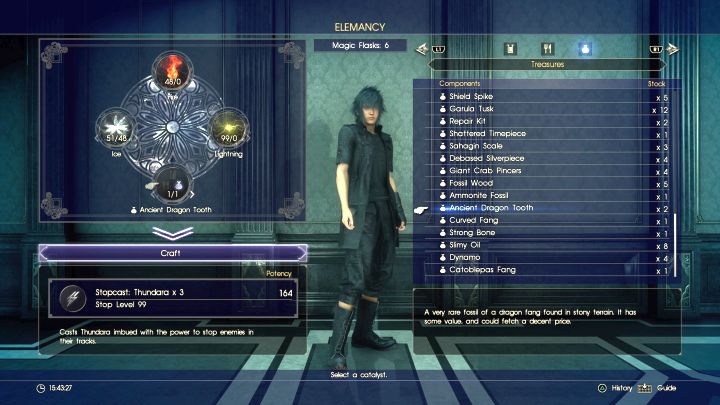
Catalysts are, basically, items that can be added to a spell mix to increase its power, or to give additional properties to it. You can use "normal" items (such as Potions, Elixirs, Remedies - "Items" group), ingredients used in cooking ("Ingredients" group) and items collected for completing quests and eliminating enemies ("Treasures" group) as catalysts. Each catalyst gives a different effect to a spell and the quality of the catalyst affects the strength of the effect. The quality is basically the rarity of a component - the harder it is to get (items dropped by powerful enemies and/or costing a lot of Gil), the more valuable the catalyst is.
Catalysts are added during the creation process, after you've added raw elements into the mixture. Thanks to that spells can gain additional effects - the ability to heal the caster, poison enemies or decrease their combat effectiveness. However, some of the catalysts are used "only" to increase the power (potency) of a spell, or the number of uses (charges). A full list of catalysts, their effects and how they affect the spell can be found in the next chapter of this guide.
Creating spells
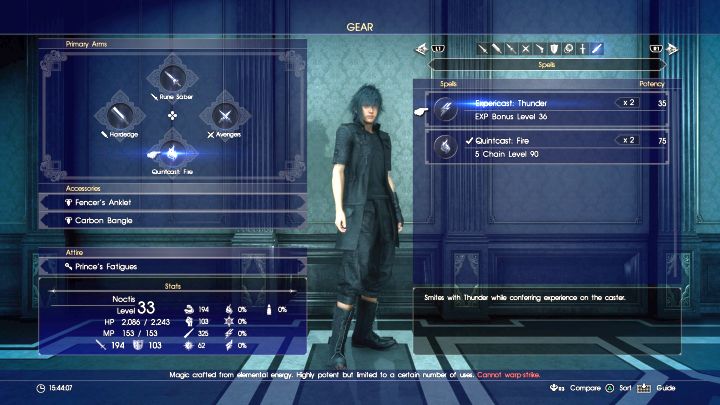
The process of spell creation is, in theory, quite simple - you just need to add the desired amount of raw elements, press the Craft and it's done. This, however, will allow you to create only basic spells, without any additional effects. You can add a catalyst into the mixture. You can add only a single type of catalyst to a spell, although you can change the amount of catalysts without limits - each subsequent piece of a catalyst will increase the power (potency) of the spell, the strength of the effect and possibly the number of uses (charges) of the spell itself.
To create a spell, enter the Elemancy window and select one of the empty flasks - you can use up or delete a spell if you don't have a free flask. Afterwards, you have to add raw elements into the mixture by using L1/LB and R1/RB (PS4/Xone) buttons, a catalyst (if you want to add it) and press the Craft button. Once done, you will be presented with two options - to equip (Equip) the newly created spell on one of your characters or to store (Store) it for later use.
You must remember about a few things associated with spells. Those are:
- Potency - the power of spells. The bigger the value, the more damage the spell will deal. It increases with each raw element added into the mixture (1 raw element is equivalent to 1 point of potency) and by using catalysts - a detailed description of all of the catalysts can be found in the next chapter.
- Tier - a "level" of spell. You will read about it in a moment.
- Effect level - the strength of the additional effect given to the spell by using a catalyst. The higher the value, the more powerful the effect is and/or the bigger the chance to apply it to the enemy.
- Uses - the number of times the spell can be used before it's completely used up and the flask is emptied.
Spell tiers
Tiers are, basically, higher levels of a spell. They don't have any impact on the amount of damage the spell will deal, but they significantly increase the area of effect. Spell tier is connected to the Potency level of it. The following table shows the tiers available to the elements of Fire, Ice and Lightning.
Tier | Element | Potency | Spell name |
1 | Fire | 1-99 | Fire |
1 | Ice | 1-99 | Blizzard |
1 | Lightning | 1-99 | Thunder |
2 | Fire | 100-199 | Fira |
2 | Ice | 100-199 | Blizzara |
2 | Lightning | 100-199 | Thundara |
3 | Fire | 200+ | Firaga |
3 | Ice | 200+ | Blizzaga |
3 | Lightning | 200+ | Thundaga |
Increasing spell Potency
There are three ways to increase the Potency of a spell. Those are:
- Adding more raw elements into the mixture.
- Adding a catalyst into the mixture - most of the catalysts available in the game increase the potency of spells. More on that can be found in the next chapter.
- Unlocking abilities from the "Magic" tree - Powercraft, Extra Powercraft, Super Powercraft and Ultimate Powercraft, increasing the potency of created spells by 10/30/50/100 points.
The second and third point is quite simple, although adding raw elements into the mixture is connected with an interesting mechanic - you can read about it below.
Adding raw elements into the mixture
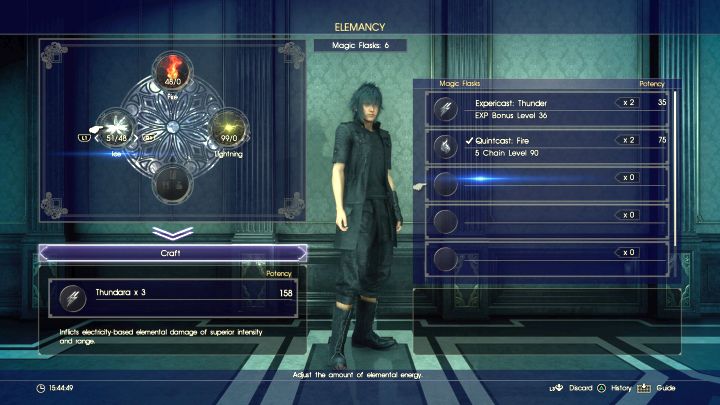
By default, each raw element (fire, for instance) adds one point of Potency to the spell. For instance: adding 50 points of fire allows you to create (without abilities and catalyst) a fire spell with 50 Potency. However, it also means that you can "normally" create spells up to 99 Potency, because you're unable to store more than 99 points of a given element.
In that case you can make use of the remaining elements - in this case Ice and Lightning. However, it's not that simple - when there's already one of the elements in the mixture (like 50 points of fire), you need to spend 2 points of other raw elements (Ice, Lightning) to increase the Potency of the spell by 1 point. This allows you to significantly increase the power of the spell without the need of catalysts (or allowing you to reduce their numbers).
There's another "problem" - proportions of elements. Adding additional types of elements into the mixture changes the spell as well. If there's majority (over 50%) of fire element in the mix, you will create a fire spell (Fire/Fira/Firaga). If, however, none of the elements have a majority you will create a Unicast spell. In that case the element of the spell you cast will be selected randomly upon usage - you can cast Fire/Fira/Firaga, Thunder/Thundara/Thundaga or Blizzard/Blizzara/Blizzaga.
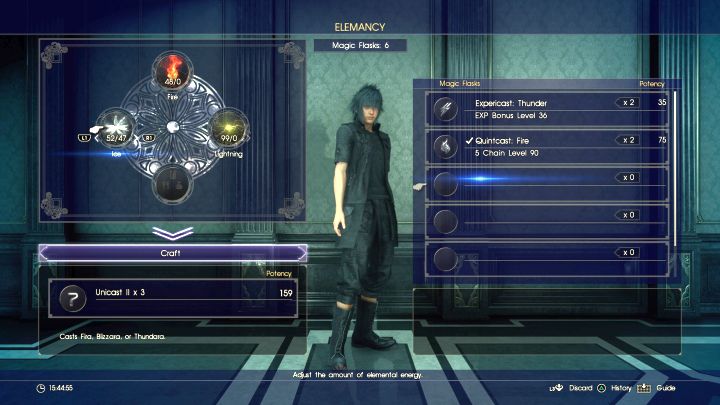
As shown above, you can create powerful spells by adding different types of elements into the mix. However, Unicast spells have a serious flaw - you won't know what element (Fire/Ice/Lightning) will be used when casting the spell (and the type is selected each time). This means that you might cast, for instance, an ice-based spell against an enemy that is resistant to this element (hence healing him).
Additional spell effects
Adding catalysts into the mixture will allow you to give a special effect to a spell. Below you can find a table representing possible combinations and their descriptions. A full list of catalysts and their effects can be found in the next chapter.
Effect | Description | Explanation |
Dualcast (2 Chain) | Allows you to cast a spell up to two times. | The first spell is guaranteed. Each subsequent spell in the chain has a chance to succeed or fail. Minimum success rate is always 50%. Success chance: 50 + (catalyst's effect level x amount of catalysts used). |
Tricast (3 Chain) | Allows you to cast a spell up to three times. | The first spell is guaranteed. Each subsequent spell in the chain has a chance to succeed or fail. Minimum success rate is always 50%. Success chance: 50 + (catalyst's effect level x amount of catalysts used). |
Quadcast (4 Chain) | Allows you to cast a spell up to four times. | The first spell is guaranteed. Each subsequent spell in the chain has a chance to succeed or fail. Minimum success rate is always 50%. Success chance: 50 + (catalyst's effect level x amount of catalysts used). |
Quintcast (5 Chain) | Allows you to cast a spell up to five times. | The first spell is guaranteed. Each subsequent spell in the chain has a chance to succeed or fail. Minimum success rate is always 50%. Success chance: 50 + (catalyst's effect level x amount of catalysts used). |
Venomcast (Poison) | Allows you to cast a spell with a chance to inflict Poison status effect on the target. | Allows you to cast a spell dealing normal damage from a specific element. Afterwards, the spell has a chance to inflict a Poison status effect on the target. A poisoned target loses health points each second. Success chance: (catalyst's effect level x amount of catalysts used). |
Cursecast (Attack Down) | Allows you to cast a spell with a chance to inflict Curse status effect on the target. | Allows you to cast a spell dealing normal damage from a specific element. Afterwards, the spell has a chance to inflict a Curse status effect on the target. A cursed target deals decreased damage. Success chance: (catalyst's effect level x amount of catalysts used). |
Stopcast (Stop) | Allows you to cast a spell with a chance to inflict Stop status effect on the target. | Allows you to cast a spell dealing normal damage from a specific element. Afterwards, the spell has a chance to inflict a Stop status effect on the target. A stopped cannot move or attack. Success chance: (catalyst's effect level x amount of catalysts used). |
Killcast (Death) | Allows you to cast a spell with a chance to inflict Death status effect on the target. | Allows you to cast a spell dealing normal damage from a specific element. Afterwards, the spell has a chance to inflict a Death status effect on the target, killing it instantly. Success chance: (catalyst's effect level x amount of catalysts used). The chance can never exceed 20%. Boss enemies are immune to this effect. |
Healcast (Healing) | Allows you to cast a spell with the Heal effect. | Allows you to cast a spell dealing normal damage from a specific element. Afterwards, restores a percent of the character's maximum health. Amount of healing: (catalyst's effect level x amount of catalysts used). |
Freecast (Free Magic) | Allows you to cast a spell with a chance of Free Magic effect happening. | Allows you to cast a spell dealing normal damage from a specific element, giving the spell a chance to not use a charge. Success chance: (catalyst's effect level x amount of catalysts used) / 100 |
Expericast (EXP Bonus) | Allows you to cast a spell with the EXP Bonus effect. | Allows you to cast a spell dealing normal damage from a specific element and adding a specific amount of experience points at the end of the encounter. The bonus is not a percent value - it's a fixed one, it doesn't matter what enemy you use it on. The Bonus EXP is calculated using this method: Effect Level x 100 - for 50 it's 5,000 experience points, 70 is 7,000 and so on. Bonuses from this spell stack up - during a single encounter you can use it multiple times, receiving thousands of experience points at the end of it. |
Failcast (Misfire) | Allows you to cast a spell with a chance to fail. | Allows you to cast a spell from a specific element, giving a chance that the spell will fail (won't deal damage). The chance to fail increases with the number of catalysts used when creating it. Fail chance: (catalyst's effect level x amount of catalysts used) / 100 |
Powercast (Compact) | Allows you to cast a spell with increased potency, but with unchanged area of effect (tier). | Allows you to cast a spell dealing increased damage, but without increasing the area of effect and tier of the spell. It allows you to cast a spell with, for instance, 200 Potency, which will be a Fire/Ice/Lightning spell, will deal enormous damage, but it will harm a single target. An effect ideal when dealing with single targets and when you don't want to harm the rest of the party. |
Blastcast (Backfire) | Allows you to cast a spell dealing damage to the target and the caster as well. | Allows you to cast a spell dealing increased damage, although the health level of the character casting it will be reduced to 1. |
Maxicast (Limit BreaK) | Allows you to cast the ultimate elemental spell. | Allows you to cast a spell capable of dealing more than 9,999 points of damage. |
You are not permitted to copy any image, text or info from this page. This site is not associated with and/or endorsed by the developers and the publishers. All logos and images are copyrighted by their respective owners.
Copyright © 2000 - 2025 Webedia Polska SA for gamepressure.com, unofficial game guides, walkthroughs, secrets, game tips, maps & strategies for top games.
